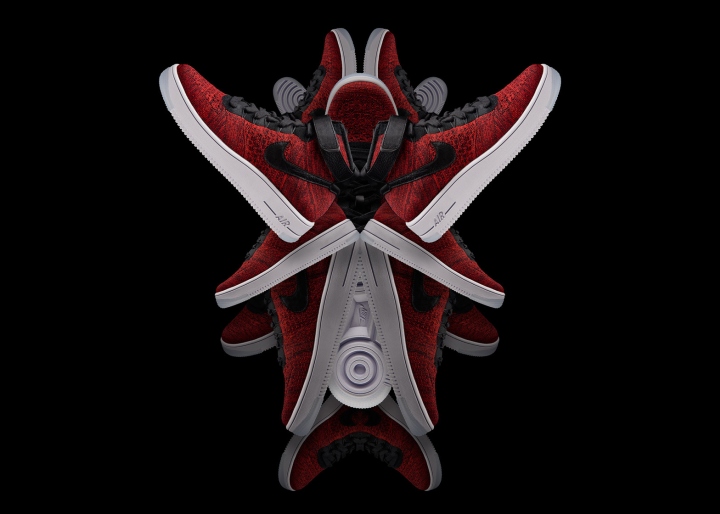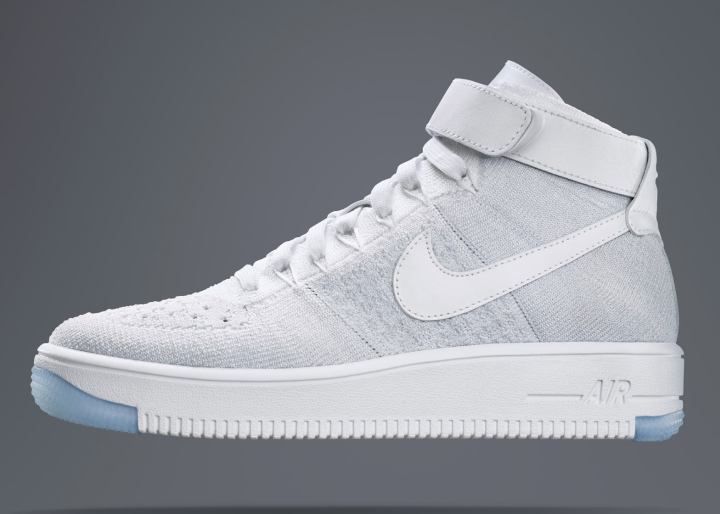


Sports brand Nike has updated its classic Air Force 1 high-top shoes, using its innovative Flyknit material to reduce the weight of the shoe by half. Launching today, the Nike Air Force 1 Ultra Flyknit is designed as a more lightweight, comfortable and longer-lasting version of one of the brand’s most iconic and popular trainers. The use of Flyknit – made from engineered yarns and knitted like a sock – allows the upper to be created as a single piece. Paired with an injected-foam sole, the shoe is 50 per cent lighter than the original leather and rubber version. “This is the lightest Air Force 1 we’ve ever designed,” said Jonson Griffin.

The first Air Force 1 was designed by Nike’s Bruce Kilgore and produced in 1982, but discontinued the following year. It was re-released in 1986 with the modern italic Nike logo and “swoosh” tick on the back of the shoe, and the design has not changed much since. The most popular model is the high-top “white on white”, featuring a thick rubber sole, a prominent toe and a velcro fastener for a strap around the top of its tongue. “We took a lot of the DNA from the overall icon, and we really wanted to translate and marry it with the Flyknit technology,” said Jonson Griffin. Flyknit was first developed in 2012 as a breathable, flexible fabric for running shoes. Nike then adapted the technology for other athletics footwear like American football boots, and is now repurposing it to add comfort to its iconic trainers. Rival sportswear brand Adidas launched its own footwear made from knitted fabric in 2014.

For the Nike Air Force 1 Ultra Flyknit, the design team took the opportunity to iron out some of the issues with the leather shoes, including creases that form in the material over time. “A lot of times, the toe or vamp of the leather shoe would start to crease, and be a sign of fatigue in the shoe,” said Jonson Griffin. “Because of the capabilities of Flyknit, it will eliminate the creases on the toe of the shoe.” Different yarn weights were combined to maintain the shape of the footwear. A thicker yarn adds volume to the toe, while the vamp is formed using thinner threads so the area of the foot that heats up the most receives better ventilation.

This is the first time that Flyknit has been combined with leather. The swoosh on the side and a panel at the back were kept in the original material to “keep a slice of the icon in tact”. Another feature Nike wanted to retain was the undulating eyestay – the part of the shoe that surrounds the lace opening – which was originally designed to create more flexibility for the lacing. Experiments with different jigs were required to recreate this shape with Flyknit.

Instead of a rubber base with a combined midsole and outsole, the team used injected foam to produce a single sole. This means the wearer’s foot sits right on top of the foam for better comfort, while removing the rubber makes the shoe more lightweight and flexible. Additionally, the embossed AIR lettering found on the side of the sole has been de-bossed. Three colour variations of the Air Force 1 Ultra Flyknit – including white on white and a red/black model – will initially be released, with more options due in the summer.

http://www.dezeen.com/2016/01/26/flyknit-material-lightest-ever-air-force-1-trainers-nike/















